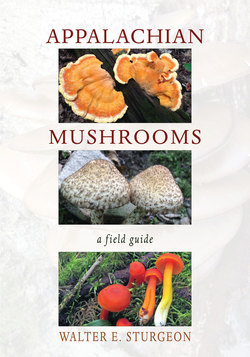Читать книгу Appalachian Mushrooms - Walter E. Sturgeon - Страница 12
ОглавлениеHOW TO USE THIS BOOK
Gilled Mushrooms
SPORE COLOR IS the starting point for identifying gilled mushrooms. Make a spore print as described in the section of this book titled “Mushroom Identification.”
Many genera will have white- to cream-colored spores. Some of these spore deposits will be a bit yellowish or, rarely, tinged violet. The common groups of mostly medium to large species are here separated into eight distinctive genera.
Amanita species have at first a universal veil, which at maturity leaves remnants at the stem base or warts on the cap. They generally have stems longer than the cap width. Of the white-spored mushrooms, this is the only genus with a universal veil. Because of toxic look-alikes, species in this genus are not recommended as edibles for beginners.
Russula species are generally squat mushrooms. Most have very brittle gills and all have brittle flesh. The gills are attached broadly to the stem. Ranging from white to black, many are colorful, with shades of red and green. Mild-tasting species are often edible, but they are also popular with slugs, rodents, and insect larvae.
Lactarius and Lactifluus species are generally squat mushrooms with gills that exude latex when cut or damaged. The gills are attached broadly to the stem. Species with mild latex are mostly edible. They are rather coarse textured.
Hygrocybe and Hygrophorus species are called wax caps. Their flesh has a waxy texture that can usually be felt by crushing a bit of the cap between thumb and forefinger. Gliophorus and Humidicutis species are also wax caps. Gliophorus species have glutinous caps and stems. Many of the species in these genera are edible, but the waxy texture, mild flavor, and often slimy caps are not popular features for most people who consume edible mushrooms.
Tricholoma is a genus of mostly gray, brown, yellowish, or white mushrooms with gills that are notched at the stem. They generally fruit in the fall. They lack latex and a universal veil. A few have a partial veil. Their flesh is not waxy textured. Many have a mealy odor. Not many species are recommended as edibles for beginning collectors.
Other white-spored mushrooms are diverse and include many genera. They have been keyed out here using size, habitat, presence or absence of a partial veil, and whether the stem is central or off center. There are many good edible mushrooms in this group.
Colored-spored genera are keyed out using spore color, habitat, size, cap color, and the presence or absence of a partial veil. There are many edible species in this group. The large, rusty-brown-spored genus Cortinarius has been treated separately. Species in this large genus have a spider web-like cortina veil when young. Many are beautiful, but it is not a genus with many edible species.
HOW TO USE THIS BOOK
Non-Gilled Mushrooms
MANY FLESHY FUNGI do not have gills. These include species with many shapes, textures, and forms.
Pored fungi include the boletes and polypores. Boletes and some polypores have stems. Many polypores have a shelving growth on wood and lack stems. Many polypores are fibrous or woody in texture. There are some good edibles as well. Boletes generally have a typical umbrella shape and fleshy fruiting bodies that typically occur on the ground. Many boletes are popular edibles. These two groups are keyed out separately using size, habitat, general shape, color, taste, pore shape, and fruiting-body toughness. Spore color can also be useful.
Chanterelles are keyed out using color, size, and undersurface features. They often have a funnel shape. Their underside is usually wrinkled or nearly gill-like. Several of these are good edible species.
Coral-like fungi are keyed out based on habitat, texture, color, and whether they are branched or not. Unbranched club fungi are included here. A few are edible. Many are hard to identify.
Spine fungi are keyed out using color, habitat, texture, and presence or absence of a stem. The spines are sometimes referred to as teeth or whiskers. Those that are terrestrial have stems and a typical mushroom shape. The wood-rotting species lack a stem or have a very rudimentary stem. There are good edibles in the genera Hydnum and Hericium.
Puffballs and their relatives are keyed out using size, colors, presence or absence of a stem, and other distinctive features. Most of these lack stems, but stinkhorns and species of the stalked puffballs in the genus Calostoma do have stems. Many of the larger, roundish puffballs are edible but rather bland, much like tofu. The best puffball dishes incorporate more flavorful species and often garlic and butter or bacon!
Cup fungi as presented here range from fragile cups to firm or gelatinous urn-like fruitings. Most are found on dead wood. Color is used as a primary distinguishing feature, along with the presence or absence of hairs. These features, along with size and fleshiness, will enable the reader to identify the species covered in this book. Three crust-like fungi are included in this section. No truly good edibles are in this group.
Jelly fungi are gelatinous and here include species with rubbery fruiting bodies. They are keyed out using color, habitat, and shape. Used in the kitchen for their texture, this is a bland-tasting group.
Morels and false morels have stems and wrinkled to honeycombed caps. Morels are generally considered among the best edible mushrooms in the world. Because some are poisonous, false morels should probably not be eaten even though there are edible species. These two groups are keyed out using color, shape, size, and cap texture.
